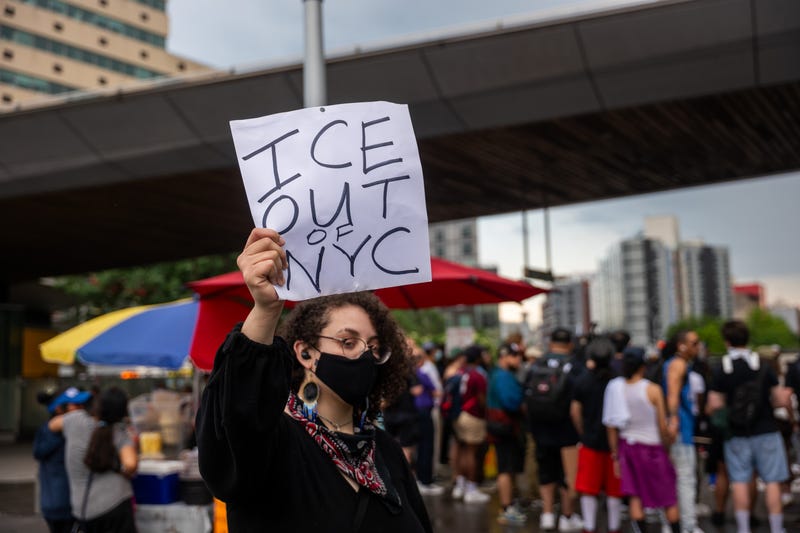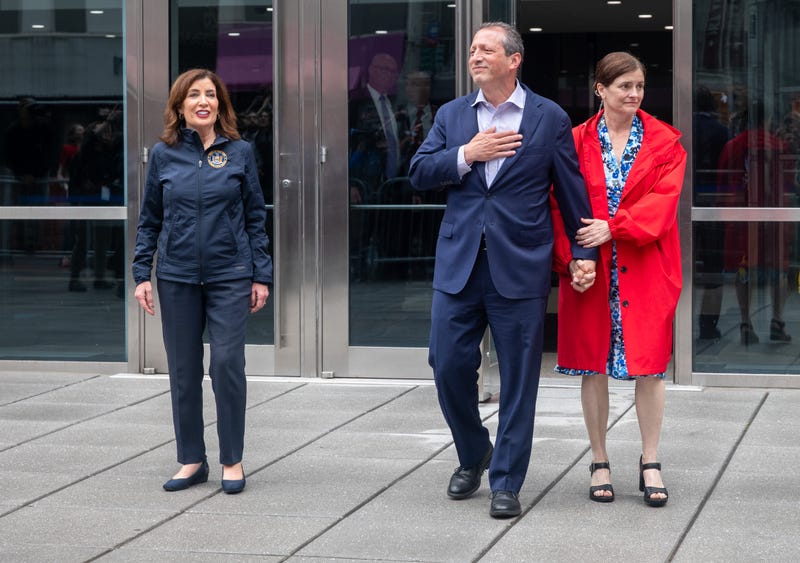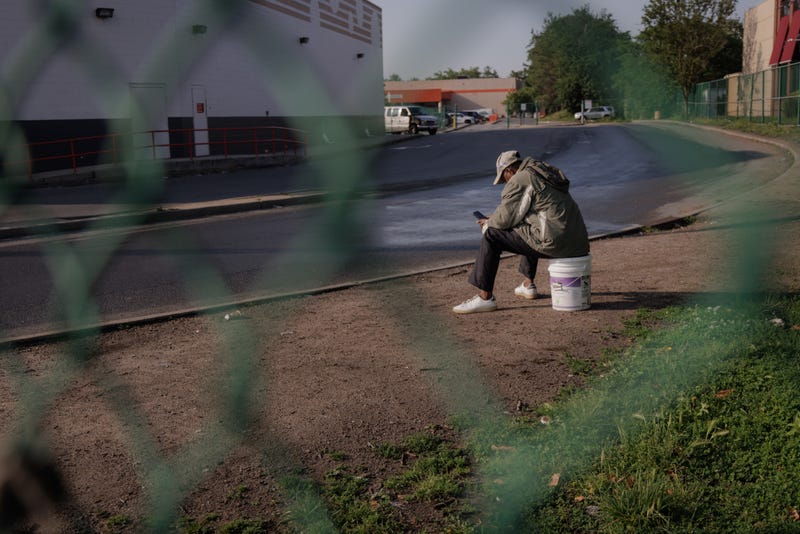
NEW YORK (BLOOMBERG) -- The Trump administration’s tactics to swiftly detain and deport immigrants has businesses and advocates in New York City bracing for a crackdown, even as new data shows fewer arrests than other big cities with large immigrant populations.
More than 1,900 people have been arrested in New York City by federal immigration authorities since President Donald Trump took office, a 31% increase from the same period last year, according to figures obtained by the Deportation Data Project and analyzed by Bloomberg. That’s far less than the increases in Los Angeles (112%), Chicago (97%) and Miami (238%).
But there’s an atmosphere of anxiety in New York, fueled in part by suspicions that city officials would increase cooperation with immigration agents and undermine sanctuary protections. “People have no idea if there are ICE vans driving around the city,” said Dave Giffen, executive director of the Coalition for the Homeless, which has worked to resettle asylum seekers in New York.
The most visible location for immigration arrests has been at a Manhattan courthouse. People appearing in federal court for routine immigration check-ins are being arrested on a daily basis. So many detainees are being held on a single floor of a court building at 26 Federal Plaza that Democrats in US Congress have described it as an unreported detention center. Camille J. Mackler, a lawyer who advocates for immigrants’ rights through her group Immigrant ARC, said a woman with a young child had been detained there last week before being deported a few days later.
Tricia McLaughlin, an assistant secretary of public affairs at the Department of Homeland Security, denied the building is a detention center. “It is a Federal building with an ICE law enforcement office inside of it,” she said. A representative for Immigration and Customs Enforcement did not respond to a request for comment on arrest numbers.

New York’s sanctuary laws do not apply at the courthouse; federal facilities are exempt. There’s been little change in how city officials interact with federal immigration authorities compared to recent years, even as there’s a widespread sense of increased enforcement activity.
Sanctuary laws mostly dictate how city employees and contractors should react to federal authorities who attempt to find and arrest undocumented immigrants on city property. For more than three decades, New York City policy has barred city officials from cooperating with federal authorities on immigration enforcement except for cases in which someone without a valid visa has committed a serious crime. Instead, the city prioritizes humanitarian access to services and economic contributions from the one in 14 residents without documentation.
That policy used to mean undocumented New Yorkers were generally safe from federal immigration agents. But ICE hasn’t limited its activity to federal buildings. New Yorkers have also reported spotting ICE agents patrolling New York neighborhoods, including Manhattan’s East Harlem and Bushwick in Brooklyn. ICE agents have requested access to at least one homeless shelter, according to the mayor’s office. (ICE has not released data on the locations of its raids or the number of people it has detained in New York City.)
As part of his national immigration crackdown, Trump has explicitly called out sanctuary cities and Democrat-run areas for enforcement. There are dozens of sanctuary jurisdictions throughout the US, including the entire state of California and cities from Minneapolis to Boston. The places with rules meant to protect immigrants now have a target on their backs. Recent raids in Los Angeles sparked days of protest and orders to deploy military forces into the city. On Monday, the Trump administration claimed in a lawsuit against the city that its sanctuary policies helped fuel riots there.
Ahead of last week’s mayoral primary in New York, immigration enforcement had become an issue. One of the candidates for the Democratic nomination, City Comptroller Brad Lander, was arrested by ICE agents on June 17 while trying to escort an undocumented man out of federal court. Zohran Mamdani, the presumptive primary winner, said ICE agents “have no interest in following the laws of this city and have solely an interest in cruelty.”
Businesses that rely on undocumented labor, including hotels, restaurants and bars, have been preparing for raids. City officials have been providing training sessions for employers and their undocumented employees. The sessions provide advice about when to call a lawyer and what kind of documentation ICE agents have to have to be admitted onto private property.
“The city’s been a great partner on this,” said Max Bookman, a lawyer representing the New York Hospitality Alliance, a trade group of restaurants and bars. The group’s executive director recently said it was too soon to tell whether the industry had already taken an economic hit as a result of deportations.

Kayla Mamelak Altus, a spokeswoman for Mayor Eric Adams, said the city was committed to adhering to its sanctuary laws. She said there had been no ICE raids in schools or hospitals, and that even churches, which aren’t city property, have been free from raids so far. She noted that funding for the city’s Office of Immigrant Affairs has jumped to $65 million for fiscal 2025, up from $52 million under the previous mayor.
Manuel Castro, the city’s immigrant rights commissioner, said in an interview that his office was working to counteract widespread fear among New Yorkers that those without legal immigration status — roughly 550,000 people, according to the Center for Migration Studies — are no longer safe using city facilities like schools, hospitals and shelters. “People stop taking their children to school, stop taking up their medication in the hospital and stop doing what they have been doing for often many decades,” Castro said.
It was this worry that first prompted a New York mayor to establish a sanctuary policy. In 1989, Mayor Ed Koch issued an executive order barring city employees from sharing information with federal immigration officials except under a narrow set of circumstances. The measure was meant to help undocumented immigrants feel safe using the city’s services, just like everyone else.
“It is to the disadvantage of all City residents if some who live in the City are uneducated, inadequately protected from crime, or untreated for illness,” Koch wrote. Each mayor who followed has defended the policy, and in 2014 Mayor Bill de Blasio expanded the provision by signing laws passed through the New York City Council.
New York City sanctuary laws bar employees and contractors from letting ICE agents enter city agencies or city-run organizations like schools without a written warrant signed by a judge. In early February, soon after Trump returned to the White House, city officials began explaining how to put the laws into practice. They circulated a flow chart, which addressed how employees should act if ICE agents or other federal immigration authorities tried to gain access to their buildings or asked for help locating particular people. The chart included instructions based on whether the agents presented valid identification or had a warrant signed by a judge.
The guidance issued by the mayor’s office has been fairly standard and mostly matches statements from the prior administration. But that hasn’t stopped the mayor from being targeted for criticism by immigration groups.
In February, Adams appeared alongside a senior Trump administration official to discuss, as one of the Fox News hosts put it, “the new alliance between ICE and Adams.” The appearance came just three days after the Justice Department convinced a federal judge to dismiss a pending criminal corruption case against Adams, over the objections of multiple federal prosecutors who resigned rather than ask for the dismissal. In one resignation letter, Manhattan US Attorney Danielle Sassoon raised the alarm that dropping the corruption charges against Adams came “in return for his assistance in enforcing the federal immigration laws.”
Adams has denied that he made a deal to have his case dismissed. His administration issued an executive order in April allowing federal law enforcement authorities, including ICE, to open an office on Rikers Island, the site of a city jail, but a judge temporarily blocked the executive order because of “the appearance of a quid pro quo involving the dismissal of his criminal charges.”
Mamelak Altus, the spokeswoman for Adams, said coordination with the Trump administration has focused on transnational gangs. She said the city will not work with federal authorities at all on civil deportation cases. And even immigrants’ rights advocates say they see no evidence that Adams or any other city leaders have decided to systemically flout the sanctuary laws.
“There has always been the one-off case where there’s a questionable interaction,” said Mackler, the immigration lawyer. “But I haven’t heard anything that suggests that they’re overall not following the laws.”
Still, that only goes so far: “Sanctuary laws don’t prevent immigration enforcement,” she said.
